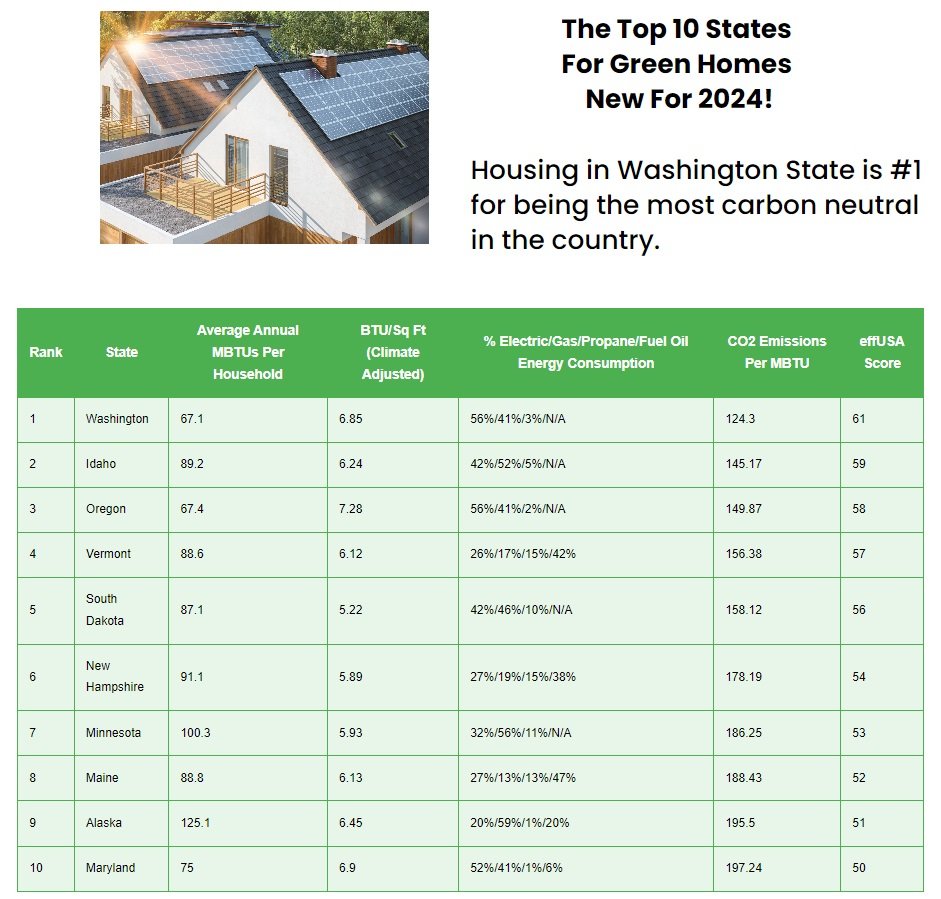Greenest Homes In America: Assessing State Performance
I recently helped develop a report that determined the “best states for green homes” for efficiencyUSA.org.
The task was immense, and I’d like to say I visited every state on the short list, but instead I simply paced back and forth in front of my laptop, trying to make sense of the numbers.
I was drowning in spreadsheets. Average home size in each state, utility data in every state, the average age and square feet of homes, and what I really got stuck on, was the number of weather days in each state.
Overwhelmed, I decided to discard all my ideas and start fresh.
What I ended up with was a simple equation:
1) Average BTUs consumed per household in each state
2) Adjusted: By impact of weather and the size of homes in each state.
3) Then: A ranking by an estimate of CO2 emissions per Btu in each state. This ranking would consider the percentage of each fuel type used by residents, the CO2 emissions associated with each, which further requires looking at the power generation mix used by the utilities in each state (renewable energy vs. fossil fuels).
(Sources: EIA, 2020 RECS Survey Data and State Profiles 2022)
I was comfortable with these factors – they tracked many of the goals for homeowners in the Inflation Reduction Act to combat climate change, both for site energy (lowering average household BTUs with the adoption of energy efficiency and more efficient heating and cooling systems with things like electric heat pumps) and the source of the energy (consumer choices and the utilities’ fuel mix).
Yet, doubt crept in. I decided to write to the EIA just to be sure. I felt there was a lot riding on this, and I wanted it to be right. A statistician got back to me and pointed out a problem with my estimating the fuel mix for electric utilities in each state. Because of interstate transfers, renewable energy for example produced within a state is not always consumed within that state, sometimes a significant portion of it is exported.
This means that a state like Minnesota may be using an even higher percentage of renewable energy across the state than the 31% of the total of in-state production number I used. The state is surrounded by two renewable energy powerhouses, Iowa and South Dakota, who export a great deal of clean power to Minnesota. But how much? Could it already mean Minnesota regularly consumes as much as 50% of its total electricity from renewable energy, the goal the state set for 2030?
I saw a neighbor who buys and sells electricity in Minnesota out inspecting something in his yard. I walked over with our dog Philly and asked him.
“There’s no way to tell that,” he said. "Wait, I suppose you could call and ask how much is coming in from those lines in South Dakota." I told him it didn’t sound practical.
So I decided to rely on utilities fuel mix for electricity generated instead of consumed in each state, figuring it still measured something. I drafted a footnote. “We believe that using the states' percentage of energy production as a marker for the mix used in electrical consumption is valid, as the two will most likely align in the near future if they don't already.”
I wrote back to the statistician at the EIA and thanked him for his input and added that I imagined they were working on a solution to measuring renewable power consumed in state from utilities both in-state and out-of-state, and I’d be back in touch.
“If it’s not ALL right now, it will be soon,” I told myself.
Weeks after reviewing it again, I still think this simple equation gives a benchmark for state policies and whether they are producing more healthy homes for occupants and the environment.
States like Vermont and Maine, number four and eight in 2024’s rankings, both have long-standing commitments to home energy programs. Maine’s recent push for the use of electric heat pumps exemplify continued initiatives. Their high rankings in our study of green homes are likely no coincidence.
To see the full results for the top 10 states along with their profiles, visit https://efficiencyusa.org/best-states-for-green-homes.


